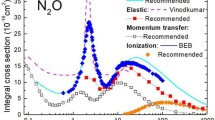Abstract
The theory of atom-molecule collisions has just seen a decade of dramatic advances. Probably the single factor which has stimulated the development and testing of a variety of new, accurate approximations was the development, in the 1960’s, by Johnson and Secrest,(1–3) Gordon,(4) Sams and Kouri,(5–9) and Chang and Light (10) of extremely efficient numerical methods for solving large sets of coupled differential or integral equations. These methods were used to provide accurate close-coupling (CC) cross sections for some atom-diatom inelastic collision problems. These results in turn have provided reliable standards against which approximations could be tested and compared. Because the same potential surfaces could be used for both the (exact) CC and approximate calculations, differences in the results provided a quantitative measure of the accuracy of the approximation. By contrast, earlier attempts to compare approximate results directly with experiment had always to contend with inaccuracies in the approximation and in the potential surface (not to mention experimental uncertainties). The present status of available numerical methods is discussed by Secrest in Chapter 8 of this volume.
Access this chapter
Tax calculation will be finalised at checkout
Purchases are for personal use only
Preview
Unable to display preview. Download preview PDF.
Similar content being viewed by others
References
B.R. Johnson and D. Secrest, The solution of the nonrelativistic quantum scattering problem without exchange, J. Math. Phys. 7, 2187–2195 (1966).
D. Secrest and B.R. Johnson, Exact quantum-mechanical calculation of a collinear collision of a particle with a harmonic oscillator, J. Chem. Phys. 45, 4556–4570 (1966).
B.R. Johnson and D. Secrest, Quantum-mechanical calculations of the inelastic cross sections for rotational excitation of para and ortho H2 upon collision with He, J. Chem. Phys. 48, 4682–2693 (1968).
R.G. Gordon, New method for constructing wavefunctions for bound states and scattering, J. Chem. Phys. 51, 14–25 (1969).
W.N. Sams and D.J. Kouri, Noniterative solutions of integral equations for scattering. I. Single channels, J. Chem. Phys. 51, 4809–4814 (1969).
W.N. Sams and D.J. Kouri, Noniterative solutions of integral equations for scattering. II. Coupled channels, J. Chem. Phys. 51, 4815–4819 (1969).
D. Secrest, Amplitude densities in molecular scattering, in Methods of Computational Physics, B. Alder, S. Fernbach, and M. Rotenberg, editors, Vol. 10, Academic Press, New York (1971), pp. 243–286.
R.A. White and E.F. Hayes, Quantum mechanical studies of the vibrational excitation of H2 by Li+, J. Chem. Phys. 57, 2985–2993 (1972).
E.R. Smith and R.J.W. Henry, Noniterative integral-equation approach to scattering problems, Phys. Rev. A 7, 1585–1590 (1973).
D. Chang and J.C Light, Exponential solution of the Schrodinger equation: Potential scattering, J. Chem. Phys. 50, 2517–2525 (1969).
R. Goldflam, S. Green, and DJ. Kouri, Infinite order sudden approximation for rotational energy transfer in gaseous mixtures, J. Chem. Phys. 67, 4149–4161 (1977);
R. Goldflam, D.J. Kouri, and S. Green, On the factorization and fitting of molecular scattering information, J. Chem. Phys. 67, 5661–5675 (1977).
V. Khare, On the l z -conserving energy sudden approximation for atom-diatom scattering, J. Chem. Phys. (in press).
W. Eastes and D. Secrest, Calculation of rotational and vibrational transitions for the collision of an atom with a rotating-vibrating diatomic oscillator, J. Chem. Phys. 56, 640–649 (1972).
J. Schaefer and W.A. Lester, Jr., Effect of rotation on vibrational excitation of H2 by Li+ impact, Chem. Phys. Lett. 20, 575–580 (1973).
S. Green, private communication.
S.I. Chu and A. Dalgarno, Fine structure transitions of C+ in collisions with H2, J. Chem. Phys. 62, 4009–4015 (1975).
M. Baer, Adiabatic and diabatic representations for atom-diatom collisions: Treatment of the three dimensional case, Chem. Phys. 15, 49–57 (1976).
F. Rebentrost and W.A. Lester, Jr., Nonadiabatic effects in the collision of F(2 P) with H2(1Ʃg+). II. Born-Oppenheimer and angular momentum coupling in adiabatic and diabatic representations, J. Chem. Phys. 64, 3879–3884 (1976).
F. Rebentrost and W.A. Lester, Jr., Resonant electronic-to-rotational energy transfer: Quenching of F(2 P1 /2) by H2 (j = 0), J. Chem. Phys. 64, 4223–4224 (1976).
P.L. De Vries and T.F. George, Quantum mechanical theory of a structured atom- diatom collision system: A + BC (Ʃ), J. Chem. Phys. 67, 1293–1301 (1977).
D.L. Miller and R.E. Wyatt, Electronuclear basis for three-dimensional electronic nonadiabatic chemical reactions, J. Chem. Phys. 67, 1302–1311 (1977).
Author information
Authors and Affiliations
Editor information
Editors and Affiliations
Rights and permissions
Copyright information
© 1979 Plenum Press, New York
About this chapter
Cite this chapter
Kouri, D.J. (1979). Inelastic Scattering Cross Sections II: Approximation Methods. In: Bernstein, R.B. (eds) Atom - Molecule Collision Theory. Springer, Boston, MA. https://doi.org/10.1007/978-1-4613-2913-8_7
Download citation
DOI: https://doi.org/10.1007/978-1-4613-2913-8_7
Publisher Name: Springer, Boston, MA
Print ISBN: 978-1-4613-2915-2
Online ISBN: 978-1-4613-2913-8
eBook Packages: Springer Book Archive




